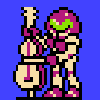inFAMOUS (PlayStation 3) review"I believe rather strongly that moral choices are one of gaming’s most frequently abused clichés, and Infamous is one of the most prominent offenders. There’s the fact that our protagonist, Cole McGrath, is a standalone character who by and large doesn’t represent the player, resulting in a narrative that awkwardly tries to combine role-playing with third-person storytelling. There are the flow-breaking asides in which Cole mentally examines his choices, and there’s the fact that his two o..." |
I believe rather strongly that moral choices are one of gaming’s most frequently abused clichés, and Infamous is one of the most prominent offenders. There’s the fact that our protagonist, Cole McGrath, is a standalone character who by and large doesn’t represent the player, resulting in a narrative that awkwardly tries to combine role-playing with third-person storytelling. There are the flow-breaking asides in which Cole mentally examines his choices, and there’s the fact that his two options always represent extremes, forcing the player to be either sickeningly sweet or aggressively, violently evil. Plus, you know how a lot of games close with one “final choice” that ultimately solidifies your alignment and negates all of the prior decisions you’ve made? Infamous does that, and then has the balls to bring the plot to the same conclusion regardless of which direction we went with.
Worst of all is that Infamous informs players that they’ll only reach the peak of their power if they choose to stick with a single alignment and max out their moral slider in one direction or the other. This removes any weight these choices have in their own context – players are making one choice, at the beginning of the game, that dictates their decisions from that moment forward. This is not how you handle moral choices; all you’re doing is giving players an excuse to replay Infamous, which a good game shouldn’t need.
I’m getting all of this out of my system now because Infamous (which I refuse to spell the obNOXIOUS way) is a very, very good game, one that is otherwise very difficult to find issue with. It contains not a single new idea, but it’s so satisfying regardless, and offers such a balanced mix of play styles, that I can’t imagine any serious gamer not liking it. I don’t want to let my lone pet peeve get in the way of my central point that Infamous hits all of the right notes, so now that I’ve gotten that out of the way, allow me to explain why every PS3 owner on the planet needs to have a copy of this game.
It is, first and foremost, an exemplary sandbox title, because it takes full advantage of its open-world nature without forsaking the game itself. It’s drawn a lot of comparisons to Crackdown, and not without good reason: It’s about a superpowered hero tasked with fighting gangs in three districts of a major city. So this is a Crackdown clone, albeit one that’s much better and refuses to make the same mistakes. Namely, it offers the free-roaming joys that a sandbox game is all about, while still giving players an actual story accompanied with a straightforward progression of objectives. Players have the freedom to choose just how open or linear Infamous is.
Cole’s superpower is that he’s electric, and it’s clear that Sucker Punch have milked that one to its extreme. His basic form of combat sees Infamous switching to a familiar dual analog control scheme and shooting lighting out of his hands in much the same manner one would fire a gun, and he later obtains attacks that resemble grenades and rockets. Other applications of his powers are less feasible: He can heal civilians, or “cuff” enemies, or drain both to restore his health, and he can also shoot heat waves (or something) out of his hands and hover like Rayman. Plus, he can survive a fall of any height without so much as a bruise. As ridiculous as some of his abilities are, they’re distributed at strategically-timed intervals throughout the game via story-related events, which raises the level of curiosity the player has over just how powerful Cole will become. By the end of the game, he’s literally raining lightning down from the heavens in a devastating attack Square Enix would probably call “summon God.”
Infamous was released around the same time as Prototype, a game that also set the player loose in an open city environment with a set of neat superpowers to play with. The big difference between the two is that Infamous is careful not to give the player too much freedom, as while it’s possible to travel through Empire City quickly, it’s still a challenge. Cole is quite good at parkour and can climb nearly any building with patience, and one of his perks is that he can “grind” along power lines and train rails like an electric Sonic the Hedgehog. The process of getting to know the city’s network of power cords and mastering the mechanics of Cole’s abilities – pairing the momentum of a successful grind with the parabola-shaped arc of his hover – perfectly encapsulates the sandbox experience while still leaving a great deal up to the player’s own skills.
What truly impresses me about Infamous, however, is how it balances its linear narrative and open environment in such a way that makes both aspects equally worthwhile. The side quests are genuinely well crafted and offer the dual purpose of awarding experience and clearing out sections of the city to make combat a less constant occurrence. Meanwhile, the central missions are varied in such a way that gives each of Infamous’s many play styles a chance to shine, where you’re never doing any one thing for too long. Action-oriented assignments are as much of a rush as nearly any shooter you’re likely to play, while the platforming bits feel tight and responsive. Escort missions in which you’re surrounded by bloodthirsty enemies are genuinely claustrophobic; segments in which Cole is racing against the clock offer an appropriate level of intensity.
Infamous by and large offers nothing to complain about – the plot is exciting, the controls are tight, the world is expansive, and the missions themselves are consistently varied and surprising. Aside from the moral choices, though, the only thing going against Infamous is that it presents us with nothing we haven’t seen before. Sandbox cities, cover-based shooter combat and parkour platforming are all commonplace in today’s gaming era, and it may very well be that few people will look back five years from now and think of Infamous as a classic. It’s by no means a system seller, as has been said, but it’s just excellent enough to make any owner of a PS3 happy they bought one.
 |  |  |  |  |
Featured community review by Suskie (January 03, 2010)
Mike Suskie is a freelance writer who has contributed to GamesRadar and has a blog. He can usually be found on Twitter at @MikeSuskie. |
|
More Reviews by Suskie [+]
|
|
If you enjoyed this inFAMOUS review, you're encouraged to discuss it with the author and with other members of the site's community. If you don't already have an HonestGamers account, you can sign up for one in a snap. Thank you for reading!
User Help | Contact | Ethics | Sponsor Guide | Links










